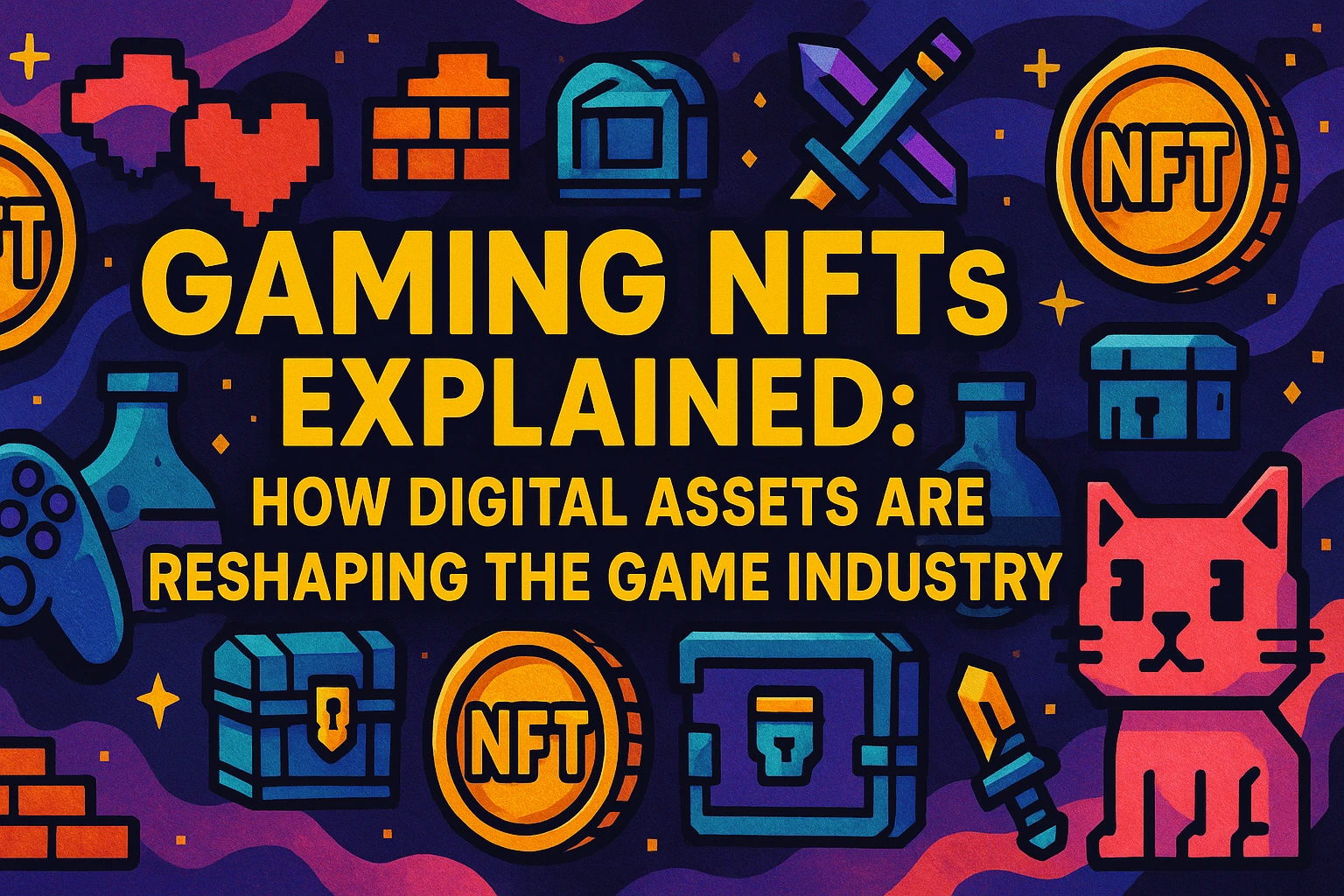The intersection of blockchain technology and video games has created one of the most significant paradigm shifts in the gaming industry’s history. If you’ve been wondering “what does NFT mean in gaming?” or “what is NFT in gaming exactly?”, you’re not alone. As someone who’s been deep in the cryptocurrency space for over five years, I’ve witnessed firsthand how gaming NFTs have evolved from experimental concepts to mainstream applications that are fundamentally changing how games are developed, monetized, and played.
NFT in gaming represents a revolutionary approach to digital ownership, where players can truly own, trade, and sometimes earn from their in-game assets. Unlike traditional gaming models where purchased items remain locked within a single game environment under the developer’s control, gaming NFT assets exist independently on the blockchain, giving players unprecedented rights and opportunities.
The gaming NFT market grew from a niche curiosity to a multi-billion dollar industry in just a few years. This growth isn’t merely speculative—it reflects a genuine transformation in how value is created and distributed in virtual worlds. Let’s explore this fascinating convergence of gaming and blockchain technology in detail.
What is NFT Gaming? Understanding the Core Concept
Defining NFT in Gaming
NFT gaming refers to video games that incorporate non-fungible tokens (NFTs) as part of their ecosystem. But what exactly does this mean?
An NFT is a unique digital token stored on a blockchain that represents ownership of a specific item. Unlike cryptocurrencies such as Bitcoin or Ethereum, which are fungible (meaning each unit is identical to another), NFTs are one-of-a-kind digital assets with verifiable scarcity and provenance.
In the context of gaming, NFTs typically represent:
- In-game characters
- Virtual land or property
- Weapons and equipment
- Cosmetic items (skins, outfits)
- Collectible cards or figures
- Special abilities or power-ups
The fundamental difference between traditional in-game items and gaming NFTs is that the latter exist independently of the game itself, on a blockchain. This provides several key benefits that have made NFT in gaming industry applications so compelling.
Key Characteristics of Gaming NFTs
When exploring what NFT means in gaming, it’s important to understand these essential characteristics:
| Characteristic | Description | Impact on Gaming |
|---|---|---|
| True Ownership | Players genuinely own their assets, not just a license to use them | Creates real-world value and secondary markets |
| Interoperability | Assets can potentially move between different games and platforms | Extends the lifespan and utility of digital items |
| Provable Scarcity | The exact number of a particular item can be verified on the blockchain | Creates authentic collectibility and value |
| Immutability | Once created, the asset cannot be altered or deleted by developers | Provides long-term stability and trust |
| Transparency | All transactions are publicly recorded on the blockchain | Reduces fraud and builds community trust |
Understanding these fundamentals helps clarify why NFT in gaming represents such a significant shift from traditional models where companies maintain complete control over all virtual assets.
The Evolution of NFT Gaming: From Experiments to Ecosystems
Early NFT Gaming Pioneers
The journey of what is NFT gaming today began with several pioneering projects that demonstrated the potential of blockchain-based ownership in virtual environments:
CryptoKitties (2017) – While not exactly a full game, this collectible breeding application on Ethereum became the first mainstream NFT project, showing how digital scarcity could drive value.
Axie Infinity (2018) – This Pokemon-inspired game became the poster child for play-to-earn gaming NFT models, where players could earn cryptocurrency by breeding, battling, and trading digital creatures.
Gods Unchained (2018) – One of the first successful blockchain-based trading card games, demonstrating how NFTs could revolutionize collectible card games by providing true ownership of digital cards.
Modern NFT Gaming Landscape
The current landscape of what is NFT in gaming has expanded dramatically from these early experiments. Today’s ecosystem includes:
- AAA Game Studios entering the space with their own NFT projects
- Specialized NFT Gaming Platforms providing infrastructure for multiple games
- Metaverse Projects where gaming NFTs form the basis of entire virtual economies
- Gaming NFT Marketplaces facilitating the buying and selling of in-game assets
- NFT Gaming Tournaments with cryptocurrency prizes and exclusive NFT rewards
This evolution represents a maturation of the space, moving from proof-of-concept projects to sophisticated ecosystems with multiple stakeholders and significant economic activity.
How NFT Gaming Works: Technical Foundation
Blockchain Fundamentals for Gaming NFTs
To truly understand what NFT means in gaming, you need to grasp the underlying technology that makes it possible. Most gaming NFT assets operate on these blockchain platforms:
- Ethereum – The original home of gaming NFTs, using standards like ERC-721 and ERC-1155
- Polygon – A layer-2 solution for Ethereum that offers faster transactions and lower fees
- Solana – Known for high throughput and low costs, popular for gaming applications
- BNB Chain – Binance’s blockchain that hosts numerous gaming projects
- Immutable X – Purpose-built for NFT games with zero gas fees and carbon neutrality
Each blockchain offers different advantages in terms of transaction speed, cost, security, and developer tools, which affects the type of NFT gaming experience that can be built.
Smart Contracts and Gaming Logic
At the technical core of NFT in gaming industry applications are smart contracts—self-executing code that runs on the blockchain. These smart contracts define:
- The properties and attributes of each NFT
- How NFTs can be created, transferred, or destroyed
- Revenue distribution when NFTs are traded
- Integration points between the game and the blockchain
- Rules for NFT staking, breeding, or evolution
This programmable layer enables complex game mechanics to be tied directly to blockchain-verified assets, creating new possibilities for gameplay and economic models.
Types of NFT Gaming Models: Diverse Approaches
Play-to-Earn NFT Games
The play-to-earn model has become synonymous with what is NFT gaming for many people. In this approach:
- Players can earn cryptocurrency or valuable NFTs through gameplay
- In-game activities like completing quests, winning battles, or farming resources yield rewards
- Player-owned assets can be sold on secondary markets for real money
- Economic systems often include governance tokens alongside NFTs
This model has proven particularly popular in developing economies where the earning potential can compete with local wages. However, the sustainability of pure play-to-earn models has been questioned, leading to new hybrid approaches.
Play-and-Own Games
A more recent evolution in the gaming NFT market focuses less on earning and more on enhanced gameplay through ownership:
- Gameplay comes first, with NFT elements enhancing rather than defining the experience
- Players purchase or earn NFTs that provide unique capabilities or experiences
- The value proposition centers on enjoyment and collectibility rather than financial returns
- Games are designed to be fun regardless of the NFT component
This approach aims for longer-term sustainability by focusing on creating engaging games that happen to incorporate blockchain technology rather than economic mechanisms with game-like elements.
NFT-Enhanced Traditional Games
Established game developers are increasingly exploring what NFT in gaming could mean for their existing franchises:
- Limited edition collectibles based on popular game characters
- Special items that can transfer between games in a franchise
- Authenticated tournament rewards or achievement markers
- Community-created content that can be bought and sold
This approach leverages existing game communities while adding the benefits of verifiable ownership and secondary markets.
Benefits of NFT Gaming: Why Players and Developers Are Embracing the Trend
Advantages for Players
The rise of NFT gaming platforms has created several significant benefits for players:
True Digital Ownership
For the first time, gamers can genuinely own their digital assets rather than merely licensing them from game companies. This ownership persists even if:
- The game shuts down
- The player is banned
- The developer makes changes to the game
Monetization Opportunities
Players can potentially profit from:
- Selling rare or valuable items they’ve acquired
- Investing early in promising games
- Creating and selling their own content in some platforms
- Participating in NFT gaming tournaments with valuable prizes
Interoperability Potential
While still developing, the promise of using your assets across multiple games and platforms represents a major shift in how we think about digital items.
Advantages for Developers
For game creators, NFT in gaming industry applications offer new business models and opportunities:
Novel Revenue Streams
- Initial NFT sales
- Ongoing royalties from secondary market transactions
- Reduced piracy concerns
- New monetization approaches beyond subscription or free-to-play
Community Engagement
- Players become stakeholders in the game’s ecosystem
- Greater alignment between developer and player interests
- Potential for community governance of game development
Reduced Platform Dependence
- Direct relationship with players without app store intermediaries
- Lower platform fees
- More control over monetization strategies
Major Players in the NFT Gaming Space
Leading NFT Gaming Companies
The NFT gaming company landscape includes both blockchain-native startups and traditional gaming firms entering the space:
- Animoca Brands – A major investor and developer in the blockchain gaming space, behind projects like The Sandbox
- Sky Mavis – The company behind Axie Infinity, one of the pioneering play-to-earn games
- Mythical Games – Creators of Blankos Block Party and advocates for “play-and-own” rather than pure play-to-earn
- Immutable – Developers of Gods Unchained and the Immutable X scaling solution
- Ubisoft – One of the first major traditional publishers to experiment with NFTs through their Quartz platform
Popular NFT Gaming Platforms
Several key NFT gaming platforms provide infrastructure for blockchain games:
- The Sandbox – A virtual world where players can build, own, and monetize experiences
- Decentraland – A virtual reality platform powered by Ethereum where users own and create content
- Enjin – A multiverse ecosystem that enables cross-game compatibility of NFTs
- Gala Games – A platform focused on giving players ownership in games through NFTs and nodes
- Wax – A purpose-built blockchain for NFTs with a focus on gaming and collectibles
NFT Gaming Marketplaces
Specialized gaming NFT marketplace venues have emerged to facilitate trading:
- OpenSea – The largest general NFT marketplace with extensive gaming collections
- Rarible – A community-owned marketplace supporting various gaming NFTs
- Magic Eden – Initially Solana-focused but now multi-chain, with strong gaming NFT support
- Fractal – A gaming-specific NFT marketplace founded by Twitch co-founder Justin Kan
- ImmutableX Marketplace – Focused on gas-free trading of gaming NFTs
Challenges and Controversies in NFT Gaming
Technical Limitations
Despite the promise of what is NFT in gaming, several technical challenges remain:
- Scalability Issues – Many blockchains struggle with transaction throughput during peak usage
- Gas Fees – Transaction costs on networks like Ethereum can make microtransactions impractical
- User Experience – Complex wallet setup and management creates friction for mainstream adoption
- Interoperability Standards – Lack of universal standards limits cross-game asset use
Economic Sustainability Concerns
Questions about long-term viability of certain models include:
- Ponzi Structure Criticisms – Some play-to-earn games require constant new player influx
- Token Value Stability – Volatile cryptocurrency prices affect game economies
- Wealth Distribution – Potential for early adopters to accumulate advantages
- Regulatory Uncertainty – Unclear classifications of tokens and earnings in many jurisdictions
Environmental Considerations
While not all NFT for web3 gaming projects have significant environmental impacts, concerns include:
- Energy Consumption – Particularly for proof-of-work blockchains
- Carbon Footprint – Environmental costs of maintaining blockchain networks
- Sustainability Practices – Growing emphasis on eco-friendly blockchain solutions
The Future of NFT in Gaming: Emerging Trends
Mobile NFT Gaming Growth
The NFT gaming app market is expanding rapidly as developers bring blockchain gaming to smartphones:
- Mobile-friendly blockchain platforms gaining traction
- Simplified onboarding for non-technical users
- Integration with existing mobile payment systems
- Lower barrier to entry compared to PC/console blockchain games
AAA Studio Adoption
Major game publishers are increasingly exploring what NFT means in gaming for their franchises:
- Experimental NFT projects from established studios
- Integration of NFT elements into existing game franchises
- Strategic partnerships between traditional publishers and blockchain platforms
- Hybrid approaches that combine traditional and blockchain-based elements
Evolution of Gameplay and Economics
The next generation of gaming NFT experiences is likely to feature:
- Greater emphasis on gameplay over earning potential
- More sustainable economic models with balanced tokenomics
- Integration of DeFi (decentralized finance) elements like staking and yield
- Dynamic NFTs that evolve based on player actions and achievements
NFT Gaming Rewards and Tournaments
Competitive gaming is being transformed by blockchain technology:
- NFT gaming tournaments with verifiable rewards and achievements
- Esports organizations creating their own token ecosystems
- Player cards and moments captured as collectible NFTs
- New tournament formats enabled by smart contract prize distribution
How to Get Started with NFT Gaming: A Beginner’s Guide
Setting Up for Success
If you’re interested in exploring what is NFT in gaming firsthand, follow these steps:
- Create a Web3 Wallet
- MetaMask for Ethereum-based games
- Phantom for Solana games
- Other chain-specific wallets as needed
- Acquire Cryptocurrency
- Purchase from a reputable exchange
- Transfer to your gaming wallet
- Consider gas fees when choosing networks
- Research Games and Platforms
- Evaluate initial investment requirements
- Check daily active users and transaction volume
- Read tokenomics documentation carefully
- Join Discord communities to learn from existing players
- Start Small
- Begin with free-to-play options if available
- Make modest initial investments
- Learn game mechanics before committing significant funds
Security Best Practices
The NFT in gaming industry requires strong security awareness:
- Use hardware wallets for storing valuable NFTs
- Enable two-factor authentication wherever possible
- Be extremely cautious of scams and “free mint” offers
- Never share your seed phrase or private keys
- Research projects thoroughly before investing
Conclusion: The Transformative Potential of NFT in Gaming
The integration of NFTs into gaming represents one of the most significant evolutions in how we create, distribute, and interact with games. By providing true ownership of digital assets and new economic models, NFT in gaming industry innovations are redefining the relationship between developers, players, and virtual worlds.
While challenges remain—from technical limitations to economic sustainability questions—the fundamental value proposition of blockchain-based digital ownership in gaming has been established. As technology improves, user experiences become more seamless, and economic models mature, we can expect gaming NFT applications to become increasingly mainstream.
Whether you’re a player seeking new experiences, a developer exploring innovative business models, or an investor looking for opportunities in the gaming NFT market, this convergence of blockchain technology and interactive entertainment offers fascinating possibilities. The future of gaming is being rewritten, one token at a time.
As with any emerging technology, critical thinking and ongoing education are your best tools for navigating this rapidly evolving landscape.
FAQ: Common Questions About NFT Gaming
What does NFT mean in gaming?
NFT in gaming refers to the use of non-fungible tokens as digital assets within video games. These blockchain-based tokens represent unique in-game items like characters, equipment, or virtual land that players can truly own, trade, and sometimes use to earn cryptocurrency.
How is NFT gaming different from traditional gaming?
The key difference is ownership. In traditional games, players merely license the use of items, which remain property of the game company. In NFT gaming, players genuinely own their assets on the blockchain, can sell them at will, and potentially use them across multiple games.
Are all NFT games play-to-earn?
No. While play-to-earn was the initial popular model, many NFT games now focus on “play-and-own” approaches where the primary value is enjoyment and collectibility rather than earning potential. The gaming NFT market continues to diversify its approaches.
How much money do I need to start playing NFT games?
It varies tremendously. Some games offer free-to-play entry points, while others require purchasing NFTs to begin. Initial investments can range from under $10 to thousands of dollars depending on the game and your goals.
Are NFT games legal?
Generally yes, but regulatory frameworks are still developing in many countries. The classification of earnings, tax implications, and gambling regulations may affect certain aspects of NFT gaming depending on your jurisdiction.
How do I know if an NFT gaming project is legitimate?
Research the development team (anonymous teams are higher risk), check community size and engagement, review the project’s roadmap and whitepaper, and assess whether the economics seem sustainable long-term. Established NFT gaming company partners can also be a positive indicator.
Can I lose money with NFT gaming?
Yes, absolutely. Between potential NFT value depreciation, cryptocurrency volatility, and project failures or scams, there are numerous ways to lose your investment. Never invest more than you can afford to lose.


